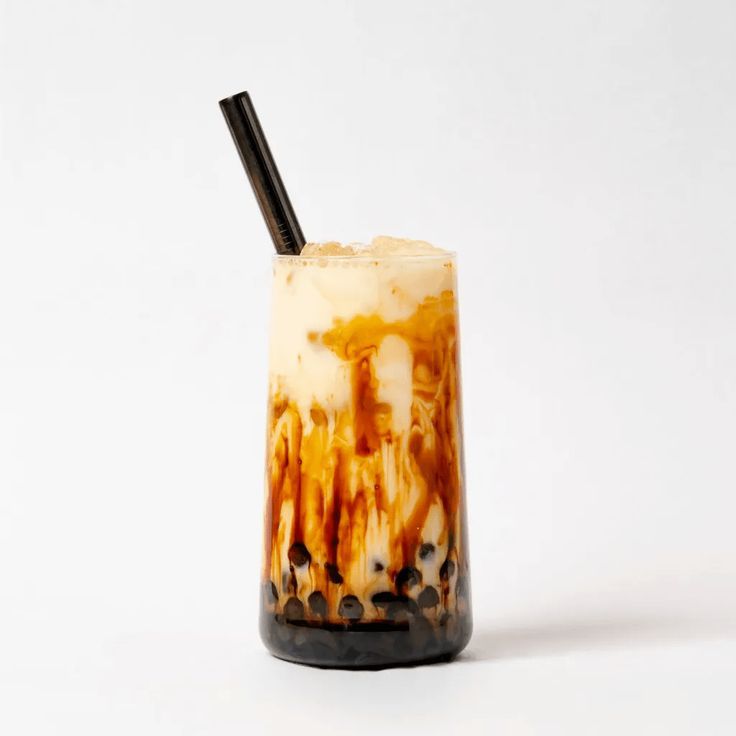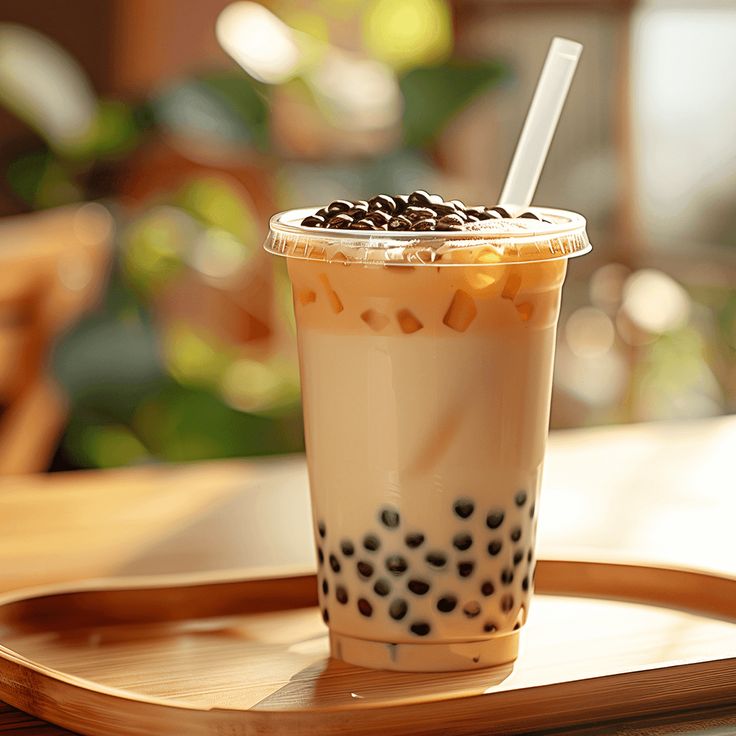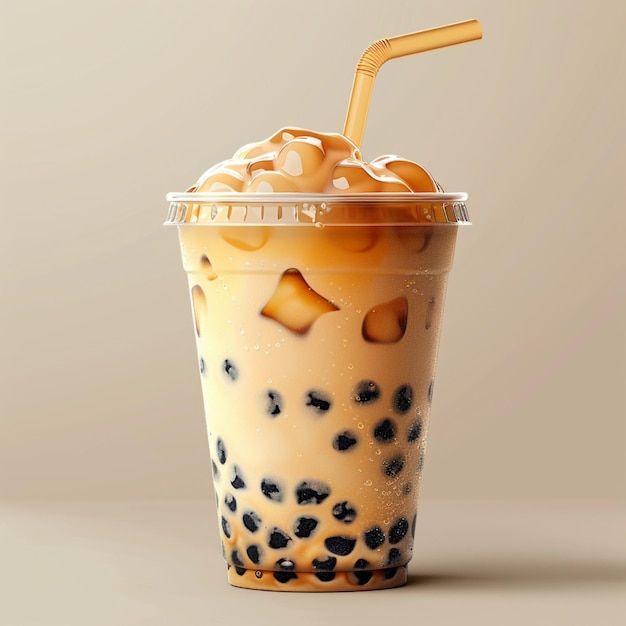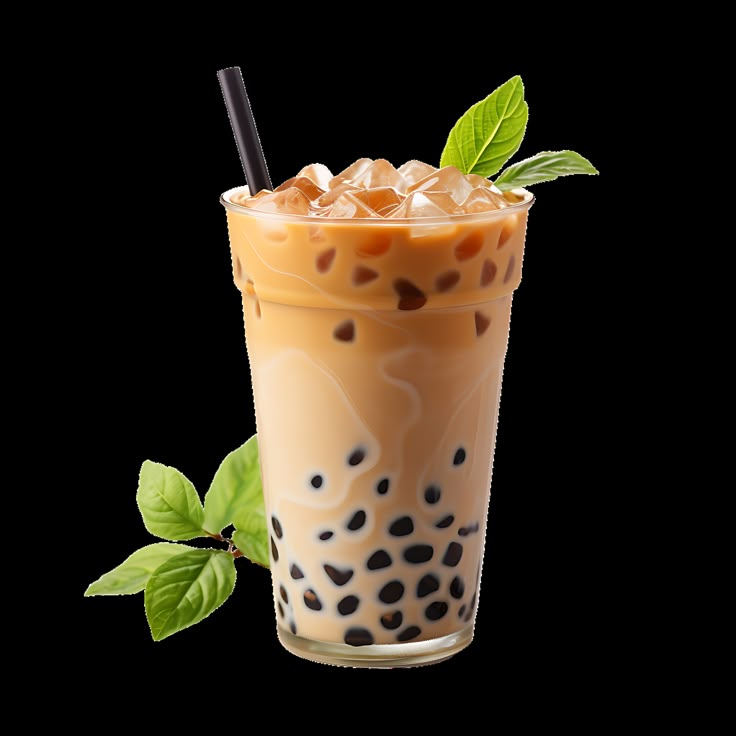History of Bubble Tea
Bubble tea’s history is as colorful as its range of flavors. This delightful drink has come a long way since its humble beginnings in Taiwan during the 1980s. A traditional Taiwanese tea-based drink, bubble tea includes chewy tapioca pearls, creating a unique experience that combines beverage and snack.
Origin of Bubble Tea and Its Cultural Roots
The story of bubble tea begins in Taiwan. Its invention often attributes to the Taiwanese tea culture, which values both flavor and fun. The drink‘s iconic tapioca pearls, also known as ‘boba,’ draw inspiration from the country’s popular sweet, tapioca pudding. These chewy pearls infused a sense of playfulness into the tea, helping it gain popularity among young generations.
With the cultural values of novelty and innovation, Taiwan was the perfect incubator for milk tea, blending traditional tea elements with modern tastes. This fusion mirrored the cultural diversity of Taiwan, attracting a dedicated following that has only grown over the years.
Evolution and Global Spread
Bubble tea didn’t stay confined to Taiwan for long. It swiftly crossed borders, gaining fans across Asia and eventually around the world. Its global spread is a testament to its versatility and international appeal. Each country has introduced its own twist to the classic recipe, adding local flavors and ingredients, thus expanding bubble tea’s reach.
The drink truly blossomed with the rise of globalization and social media, which amplified its visibility. As more people sought out this unique beverage, entrepreneurs spotted an opportunity, and milk tea shops began popping up globally. As the internet era took hold, pictures and videos of vibrant bubble teas went viral, cementing its status as a global trend.

Understanding Bubble Tea Ingredients
Bubble tea’s worldwide charm lies not just in its history but in its unique combination of ingredients. To truly appreciate bubble tea, you must understand the individual components that create its signature taste and texture. These elements work harmoniously together, resulting in an enjoyable beverage experience.
The Essential Components: Tea, Milk, and Tapioca Pearls
At the heart of bubble tea are three foundational ingredients: tea, milk, and tapioca pearls. The base tea, often black or green, provides a robust canvas for the distinct flavors of bubble tea. Choosing the right tea is essential; authentic teas create a deep and complex flavor profile that enhances the entire drink. The aromatic notes of the tea complement other ingredients, ensuring a well-rounded experience.
Milk adds a creamy richness to the drink. It balances the natural bitterness of the tea and contributes to the silky texture that bubble tea enthusiasts love. Customers often have options between dairy and non-dairy alternatives. Almond, soy, and oat milk are popular choices that cater to different dietary preferences while providing their creamy touch.
Tapioca pearls are the stars that give milk tea its name. These chewy spheres offer a playful contrast to the smooth drink. Made from cassava starch, the pearls are cooked until they achieve a unique gummy bear-like consistency. This chewy texture creates an enjoyable tactile experience as you sip your milk tea. When combined with the sweetness of the milk and tea, tapioca pearls elevate the overall taste.
Variety of Flavors and Customizations
One of the most appealing aspects of bubble tea is its adaptability to a multitude of flavors and customizations. From the classic milk tea to fruit-infused variations, the possibilities seem endless. Whether you want a refreshing mango bubble tea or a rich chocolate variant, there’s something to suit every palate. The flavor spectrum includes exotic fruits like lychee and passion fruit, as well as rich options such as chocolate and caramel.
The fun doesn’t stop at basic flavors. Add-ins such as fruit jellies, popping boba, and grass jelly allow consumers to tailor their bubble tea experience. Popping boba provides an extra burst of flavor, while fruit jellies add texture and sweetness. Each add-in serves to enhance the beverage further, allowing each cup of milk tea to offer something new.
Customizations extend beyond flavors. Customers can choose their sugar levels and ice amounts. Whether you like it extra sweet or mildly flavored, there’s an option for you. You can even select tea types based on personal preference. This versatility ensures that bubble tea caters to a wide array of tastes and dietary preferences, contributing to its immense popularity. By experimenting with different combinations, bubble tea fans can enjoy a personalized beverage that always hits the right notes.

Health and Nutritional Aspects
As bubble tea continues to captivate taste buds around the world, it’s essential to consider its health and nutritional aspects. Understanding these factors can help enthusiasts enjoy bubble tea in a balanced way, ensuring they make informed choices about what they drink.
Calorie Content and Nutritional Values
Bubble tea’s calorie content can vary significantly based on its components and serving size. Typically, a regular-sized bubble tea contains calories ranging from 200 to 450. Many factors influence this range. The most significant contributors to the calorie count are the sweeteners and the tapioca pearls.
Tapioca pearls are starchy and high in carbohydrates, which makes them energy-dense. On top of that, added sugars or syrups enhance the drink’s flavor, further increasing its calorie content. People looking to manage their caloric intake should be aware of these factors. While bubble tea is often considered a treat, monitoring portion sizes can help maintain a balanced diet.
Despite the calorie count, bubble tea does offer some nutritional value. Depending on the specific ingredients used, consumers may benefit from small amounts of calcium and vitamin C. For example, the inclusion of milk or fruit can enhance the drink’s nutritional profile. While bubble tea may not be a superfood, being mindful of its constituents can enhance its value.
Healthier Options and Alternatives
For health-conscious consumers, multiple ways exist to enjoy bubble tea without guilt. Opting for low-calorie sweeteners or reducing the overall sugar content can significantly impact the drink’s calorie count. Many bubble tea shops offer the option to customize sweetness levels, allowing individuals to adjust their beverages based on personal preference.
Additionally, choosing teas rich in natural antioxidants, such as green tea, creates a healthier choice. The antioxidants in green tea have been linked to numerous health benefits, including improved heart health and enhanced metabolism. Alternative milk options, like almond or oat milk, can lower calorie content while providing different nutrient profiles, such as healthy fats.
Moreover, some shops now feature healthier ‘boba’ options made from ingredients like konjac. These alternatives often have fewer calories than traditional tapioca pearls. By being mindful of these choices, bubble tea lovers can indulge in their favorite drink while maintaining a healthier lifestyle. Making small changes can transform bubble tea into a delicious yet nutritious option.

Preparation and Serving Styles
Bubble tea preparation and serving styles have evolved, with traditional and modern techniques influencing how we enjoy this beverage. The method of preparation greatly affects the taste and quality of the final product, making it an essential aspect of the bubble tea experience.
Traditional Methods versus Modern Techniques
Traditional methods of making bubble tea involve brewing tea leaves, cooking tapioca pearls, and mixing the drink by hand. Typically, this process is time-consuming but is praised for its authenticity and the ability to customize each cup. Meanwhile, modern techniques incorporate automated machines for efficiency. These machines can rapidly produce consistent cups of milk tea, ensuring quick service that caters to high-volume demands. Some shops blend the old with the new, using quality ingredients but embracing technology for speed and consistency.
Dine-In Versus Take-Out Experience
The choice between dine-in and take-out also defines the milk tea experience. Dine-in patrons can enjoy their bubble tea freshly made, often with the opportunity to see it crafted before their eyes. This setting allows for a more relaxed enjoyment, often accompanied by the inviting atmosphere of the milk tea shop. Take-out, on the other hand, provides convenience and mobility, suiting those on the move. Most shops cater to both options, with packaging designed to maintain the drink’s integrity during transit. This flexibility in serving styles has contributed to bubble tea’s popularity, meeting the diverse needs of consumers worldwide.
Impact on Business and Economy
Bubble tea has significantly impacted the business landscape and economy, particularly in the food and beverage sector. The drink’s popularity has fueled the growth of a distinctive industry around it, spanning from local kiosks to international franchises.
Rise of Milk Tea Franchises and Small Businesses
The boom in bubble tea’s popularity has led to the surge of franchises and small businesses. As the demand grew, entrepreneurs seized the opportunity to build a dedicated customer base. Bubble tea franchises quickly became a hot investment, with major brands expanding across continents. Likewise, small businesses also found a niche, offering customized flavors and local twists. These establishments became not just places to enjoy a drink but social hubs, especially for the youth.
Entrepreneurs have found success in the personalization of milk tea, from DIY bars to limited edition flavors. This adaptability in business models has allowed a wide range of ventures to thrive, each carving out a unique space in the market.
Economic Influence of Milk Tea on Local Markets
The influx of bubble tea shops has had a noticeable economic influence on local markets. These outlets contribute to the economy by creating jobs and driving consumer spending. The raw materials, such as tea leaves, milk, and tapioca pearls, often source locally, supporting regional agriculture and industries.
Moreover, the milk tea phenomenon has sparked ancillary businesses, including suppliers for the signature cups and straws, equipment manufacturers, and professional training services. The beverage’s popularity also stimulates innovation in payment methods and delivery services to enhance customer convenience. This ripple effect demonstrates milk tea’s substantial economic impact beyond the direct sales of the drink itself.

Popularity and Cultural Phenomenon
The rise of bubble tea is undeniably intertwined with social media and its influence on youth culture. This section explores how milk tea has become more than just a drink—it’s a cultural icon.
Trends in Social Media and Youth Culture
Bubble tea has gained massive popularity among young people, largely through social media platforms. Instagram, TikTok, and Snapchat are filled with colorful images and videos of milk tea, making it a trend that people want to share and be a part of. It’s not uncommon to see groups of friends gathering at milk tea shops, snapping pictures of their drinks to post online. Hashtags like #bubbletea and #boba have millions of posts, showing its widespread appeal. Social media influencers often showcase their visits to new bubble tea spots, further fueling the trend.
Tapping into the DIY and customization trend, many young consumers enjoy creating their own milk tea flavors. This personalization aspect ties in with the desire for unique experiences that can be shared on social media. As a result, milk tea is associated not only with taste but also with fun, creativity, and community.
Bubble Tea in Popular Culture and Media Exposure
Bubble tea has transcended its status as a mere beverage to become a cultural phenomenon. It features in TV shows, music videos, and films, especially in scenes that portray contemporary urban lifestyles. It has also been the inspiration behind merchandise like t-shirts, phone cases, and jewelry, showcasing its influence on popular culture.
Celebrity endorsements and product placements have played a significant role in promoting milk tea. As stars are seen enjoying the drink, fans are encouraged to try it themselves. This media exposure contributes significantly to the hype around milk tea and has helped it stay in the public eye. The presence of bubble tea in various forms of media confirms its place as a modern cultural symbol, especially among younger generations.

Future of Milk Tea
As bubble tea continues to swell in popularity, its future seems flavorful and bright.
Innovations and Trends Shaping the Market
The bubble tea market isn’t just growing, it’s evolving. Here’s how:
- Flavor Fusion: Expect to see ever-more unique combinations. Even savory tastes may get mixed in.
- Tech Touch: Ordering systems and AI may offer personalized recommendations for a tailor-made sip.
- Health Wave: Sugar-free and organic options could become standard as health trends rise.
Innovation keeps milk tea fresh and exciting. New trends ensure it stays a hot talk-around.
Sustainability and Environmental Considerations
Awareness is brewing in the milk tea industry:
- Eco-Friendly Packaging: Biodegradable cups and straws might replace plastic.
- Local Sourcing: Ingredients from nearby suppliers could cut transport emissions.
- Waste Reduction: Refillable cups and zero-waste stores are already popping up.
As eco-consciousness grows, bubble tea’s future is not just delicious, but also greener and kinder to our planet.